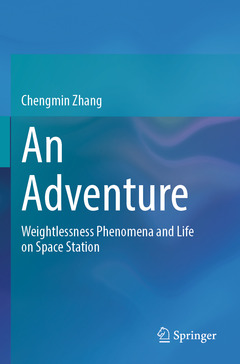An Adventure, 1st ed. 2023 Weightlessness Phenomena and Life on Space Station
Auteur : Zhang Chengmin

This is a popular science book surrounding astronauts? life on the space station. The book not only highlights the weightlessness experience of astronauts and the extraordinary phenomena they witness, but also illustrates the physics behind these events, which opens a new window for readers to explore the outer space. This book is especially fun for those who are curious about the life details of astronauts on the space station. The book is based on real events, and features images and cartoons that vividly depict unusual scenes between the outer space and the earth. Physical principles become easier to understand with these visual aids. During the reading, readers can immerse themselves in the enjoyable adventure of space travel and the strange feeling of weightlessness while having their doubts of every oddity solved. The book elaborates on the interesting contrast between the space and the earth, and provides readers with a stunning new perspective with easily comprehensible language and examples.
Preface
0 Introduction:Why do we fly into the space?
1 Free fall and weightlessness in gravity
1-1 The story of Isaac Newton and the apple falling
1-2 Why does a cannonball fall down to earth but the moon does not?
1-3 Why do scientists launch spacecrafts from the equator?
1-4 Weight and weightlessness
1-5 The wonderful world of microgravity
2 Measure the body weight on space station
2-1 Measure the weight on the ground
2-2 Measure the “weight” or mass of astronaut on space station
2-3 Why do we confuse weight and mass?
2-4 Mass and weight from north pole to equator
2-5 How is Earth’s mass measured?
2-6 Short summary on mass and weight
3 The space swing never stops
3-1 Constructing a simple pendulum
3-2 A pendulum anchored in the cosmos
3-3 The mystery of swinging
3-4 Keeping time with a pendulum
3-5 Simple pendulum motion in gymnastics
3-6 A pendulum in weightlessness state
4 The Gyroscope on space station
4-1 Stability of a spinning gyroscope
4-2 Gyroscope in weightlessness
4-3 Gyroscopes in our daily life
4-4 Gyroscopes in universe: Earth and pulsar
5 Wonders of water in weightlessness
5-1 Shape of water drop in weightlessness
5-2 Thin film of water on space station
5-3 Super water globe ball and cocktail on space station
5-4 Amazing surface tension
5-5 Disappearance of buoyancy force in weightlessness
6 Viewing universe and Earth on space station
6-1 Why are stars not twinkling seen from space station?
6-2 Space station: 16 times of sunrise or sunset in one day
6-3 Why is Earth shown as a blue planet?
6-4 Moon is much brighter seen on space station
6-5 Can naked eye see the Great Wall from space station?
6-6 Space telescope from Hubble to James Webb
7 Wonderful space life:part one
7-1 Playing with fire on space station: round flame
7-2 Will people shed tears on the space station?
7-3 Will the astronauts become taller on space?
7-4 Spacewalking outside of a spacecraft
8 Wonderful space life: part two
8-1 Sleeping in weightlessness
8-2 Drinking and eating on space station
8-3 Brushing teeth and taking shower on space station
8-4 Space toilet and water cycling system
9 Extended knowledge and products based on space exploration
9-1 Effects of weightlessness on women and men
9-2 Animals respond to weightlessness
9-3 Risk of cosmic rays and solar wind storm on astronauts
9-4 Plant growth on space station9-5 Broad knowledge inside the spacesuit
10 Postscript: Flying into space is a human dream
Chengmin Zhang received his Ph.D. in astrophysics from the University of Hong Kong (China). He then conducted postdoctoral research at IFT-UNESP (Brazil), School of Physics at the University of Sydney (Australia). He also served as a visiting scientist at several international institutions, e.g., Max Planck Institute for Extraterrestrial Physics (Germany), Albert Einstein Institute (Germany), Institute for Astrophysics Potsdam (Germany), Mathematical Sciences Institute at Australian National University (Australia). Dr. Zhang is now a research professor at National Astronomical Observatories, Chinese Academy of Sciences, and teaching professor at the University of Chinese Academy of Sciences, Beijing (China). He is a member of International Astronomical Union and a senior scientist on astrophysics and space science. In addition, Dr. Zhang is a former live guest commentator for the first broadcast of the Chinese Astronauts Space Class (Tiangong) on China Central Television, which has become the most watched space education program in the world, with more than 200 million viewers worldwide, including 60 million secondary school students.
Describes clearly the phenomena of losing weight in space using astronauts’ experiences and experiments
Explains the physical causes of the weightlessness by comparing events in space and on earth
Uses text and cartoon illustrations to show what happens in gravity and free-fall environments
Date de parution : 02-2024
Ouvrage de 91 p.
15.5x23.5 cm
Date de parution : 02-2023
Ouvrage de 91 p.
15.5x23.5 cm



